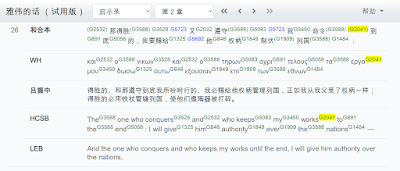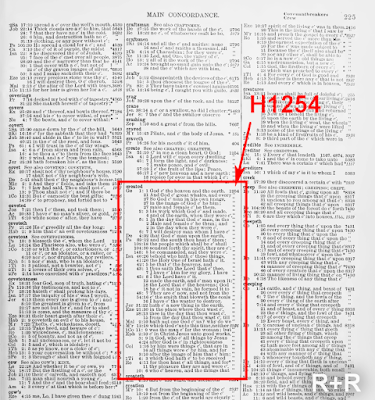YHWH - 神 - 主
在旧约中,“神”的希伯来词是 Elohim。神也被称为“主”,是希伯来语 Adonai 的翻译。然而,出埃及记 3:14 -15 中神的独特专有名称是 YHWH,可以大至翻译为“我是”。
对古代犹太人来说,他们清楚知道神的名字,毫不混淆。
然而,由于他们几百年以来都不服从神,并崇拜其他假神,神一次又一次地派遣先知(他的代言人)警告和纠正他们,但无济于事。
然后神容许灾难发生了:犹太人王国的灭亡(北国以色列于公元前722年,南国犹大于公元前586年)。大部份人被掳出境并流放了70年。
当犹太人返回并重建他们的祖国后,他们的宗教习俗发生了重大变化。
他们认为他们的问题按照十诫来说,是妄称了神的名,所以他们极端化了,从第二圣殿时代开始,他们就养成了从不再说神名的习惯。 而是使用“Adonai 主” 来表达。
但这不是 יהוה 的翻译,而是一种替代,完全埋没了神的名字。
《塔木德》说,这个名字只有神殿的祭司才能说。
对当时以至现代的犹太人来说,神的名字是不可读出的。
对于英文圣经,自 钦定本(KJV) 以来,大多数翻译都同样使用普通名词“LORD”(用小写字母书写)来代替。同样,这不是 יהוה 的翻译,而是一种替代,完全隐藏了神的名字。
这一传统在 19 世纪前后被 2 部圣经暂时打破,即杨格(他是杨格氏汇编的作者)的直译本 (Young's Literal Translation, YLT 1862) 和美国标准版 (American Standard Version, ASV 1901)。
杨氏在第二版(1898 年)的直译中,将整本旧约中的希伯来四字神名译为“Jehovah耶和华”,而不是按传统的做法,用小写字母表示为“LORD”。
我们要更多地关注美国标准版 (ASV)。
ASV是美国人在修订版(Revised Version, or English Revised Version, RV/ERV,由英国人于 1885 年出版。它是对 钦定本(KJV 1611) 的完整和重大修订)。
RV/ERV 和 ASV 都是在 和合本CUV 翻译期間出版的。 和合本是基于 RV/ASV 的英文文本,这些是当代最新的英文圣经。
许多读者都知道 和合本與 欽定本 中间存在許多差異,但很少有人知道 CUV 是基于 RV 的。 我们这一代人对RV一点都不熟悉,这是基於另一个事实,RV很快又被改版了,1952年又出了一个更新的标准修订版Revised Standard Version, RSV。我是在RSV时代、使用RSV长大的。
RSV 后来成为另外两个修订版的基础——新修订标准版 (New Revised Standard Version, NRSV 1989) 和英文标准版 (English Standard Version, ESV 2001)。
ASV
ASV 在对 RV 进行了一些细微更改的同时,还有 2 个更重要的更改:
- 全能者的神圣名称(四字神名)在 ASV 旧约圣经的 6,823 处始终使用Jehovah,而不是在钦定本 或 (英)修订版 中的LORD。
- 钦定本中只有七节经文出现了Jehovah:创世记 22:14、出埃及记 6:3、出埃及记 17:15、士师记 6:24、诗篇 83:18 和以赛亚书 12:2、26:4 以及它的缩写形式,Jah (诗篇 68:4 )。
- 英文修订版 (RV 1881–1885) 将 Tetragrammaton 翻译为Jehovah 15次,除了钦定本外,另加八次。 (出埃及记 6:2,6-8、诗篇 68:20、以赛亚书 49:14、耶利米书 16 中: 21 和哈巴谷书 3:19 ,加上其缩写形式 Jah,在诗篇 68:4 和诗篇 89:8 中出现两次。)
- 用 “Holy Spirit圣灵” 取代 “Holy Ghost”。
所以,和合本把YHWH译为音译"耶和华" 而不是LORD(主),并非没有先例。
YHWH - God - LORD
In the Old Testament, the Hebrew word for “God” is Elohim. God is also called “Lord,” which is a translation of the Hebrew Adonai. However, the special proper name of God that is given in Exodus 3:14 -15 is YHWH, which could be roughly translated as "I AM”.
The ancient Jewish people knew the name of their God without any confusion.
However, as they disobeyed YHWH and worshipped other false gods throughout the centuries, God, time and time again, sent prophets (His spokesmen) to warn and correct them, but to no avail.
Then God allowed catastrophes to happen: the fall of the Jewish kingdoms (Nothern Kingdom Israel in 722BC and Southern Kindom Judah in 586BC). The majority of the population was deported and exiled for 70 years.
After the Jews returned and rebuilt their fatherland, there was a substantial change in their religious practice.
They thought their problem was taking the name of God in vain, according to the Ten Commandments, so much so that they took the matter to the extremes, to the point that, since the Second Temple era, they made a habit of never saying Yahweh, instead typically using the expression "Adonai", which means Lord.
But this is not a translation of יהוה, it is a kind of substitution, which obscures the name of God altogether.
The Talmud said that the Name was spoken only by priests in the Temple.
To the Jews, then and now, the Name of God is unpronounceable.
For English Bibles, since the KJV, most of the translations used the common noun “LORD” (written in small caps). Again, this is not a translation of יהוה; it is a kind of substitution, which obscures the name of God altogether.
This tradition was temporarily broken in the 19th century, by 2 Bibles, the Young's Literal Translation (YLT 1862) and the American Standard Version (ASV 1901).
Young's Literal Translation in the second edition (1898) consistently renders the Hebrew tetragrammaton (divine name) throughout the Old Testament as "Jehovah", instead of the traditional practice of representing the tetragrammaton in English as "LORD" in small capitals.
More attention should be paid to The American Standard Version. It was produced by Americans after the Revised Version (also known as the English Revised Version ERV, produced by the British in 1885. It was a complete and major revision of the KJV (first published in 1611).)
Both the RV(ERV) and the ASV were published in the same era while the CUV translation was underway. The CUV was based on the English text of the RV/ASV, as these were the latest revision of the English Bible at that time.
Many readers are aware of the difference between the CUV and the KJV, but few are aware that the CUV was based on RV. Our generation is not familiar with the RV at all as this is due to one fact, that the RV was revised again and a newer version Revised Standard Version came out in 1952. I was brought up in the era of RSV.
The RSV later served as the basis for two more revisions—the New Revised Standard Version (NRSV 1989), and the English Standard Version (ESV 2001).
The ASV
However, the ASV while making some minor changes from the RV, there were 2 more significant changes:
(1) The divine name of the Almighty (the Tetragrammaton) is consistently rendered Jehovah in 6,823 places of the ASV Old Testament, rather than LORD as it appears mostly in the King James Bible and Revised Version of 1881–85.
- There are seven verses in the King James Bible where the divine name appears: Genesis 22:14, Exodus 6:3, Exodus 17:15, Judges 6:24, Psalm 83:18, and Isaiah 12:2, 26:4 plus its abbreviated form, Jah, in Psalms 68:4.
- The English Revised Version (1881–1885) renders the Tetragrammaton as Jehovah where it appears in the King James Version, and another eight times in Exodus 6:2,6–8, Psalm 68:20, Isaiah 49:14, Jeremiah 16:21 and Habakkuk 3:19 plus as its abbreviated form, Jah, twice in Psalm 68:4 and Psalm 89:8.
(2) using the words "Holy Spirit" instead of "Holy Ghost".
So CUV is not without precedent in rendering YHWH as phonetical transliteration instead of LORD.
👲
















